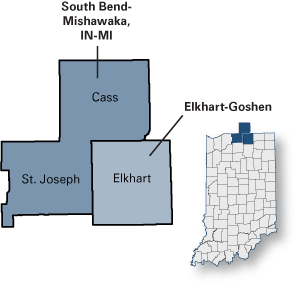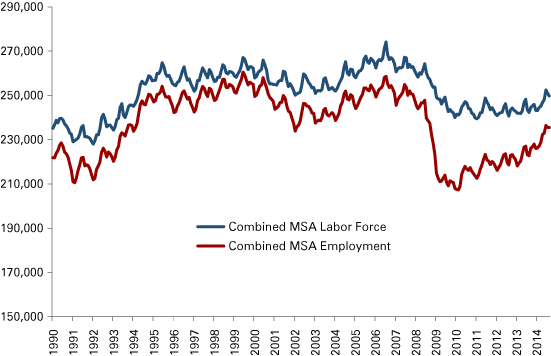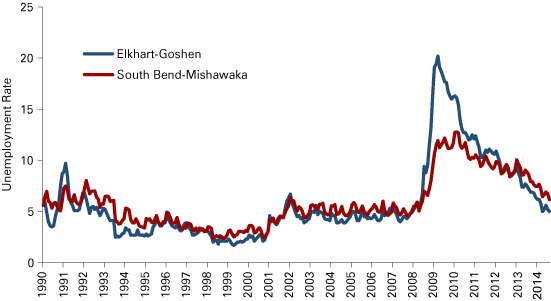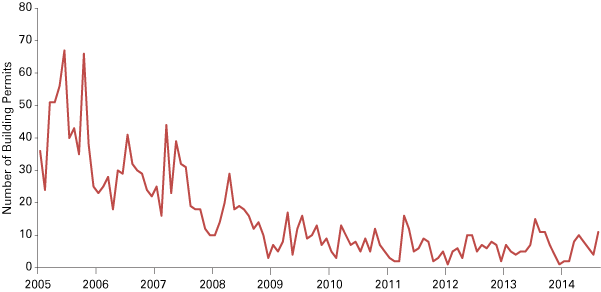South Bend and Elkhart Area Forecast 2015
Director, Bureau of Business and Economic Research, Chair and Associate Professor of Economics, Judd Leighton School of Business and Economics, Indiana University South Bend

The South Bend-Mishawaka Metropolitan Statistical Area (MSA) and Elkhart-Goshen MSA rebounded in 2014 with an expanded regional economy, a larger labor force, increased employment, a lower unemployment rate and a slowly recovering housing market. This upbeat news was tempered by slightly negative earnings growth.
Real Metropolitan GDP
The exciting news is that the combined size of the local economy—the South Bend-Mishawaka MSA and Elkhart-Goshen MSA—measured by its real metropolitan gross domestic product (RGDP) was $4.3 billion higher in 2013 (an increase of 22 percent) than its low in 2009.1
The Elkhart-Goshen MSA grew by $3.77 billion (48 percent) while the South Bend-Mishawaka MSA grew by $0.6 billion (5 percent) from their respective recession lows. The combined production level for the region was nearly $307 million below its pre-recession 2007 level. The Elkhart MSA’s RGDP was about $18 million below the 2007 pre-recession level, while the South Bend-Mishawaka MSA’s RGDP was $289 million below its 2007 level.
Labor Force and Employment
The local economy’s labor force continued to trend up since the beginning of 2014 (see Figure 1). In August 2014, the combined labor force stabilized at 249,697 workers, after steadily declining from the record high of 274,111 workers in July 2006.2 As a result, the region’s combined labor force in August 2014 was 24,414 workers smaller than its July 2006 level and 12,870 workers lower than its August 2007 pre-recession level.
Figure 1: Labor Force and Employment in the Elkhart-Goshen and South Bend-Mishawaka MSAs Combined, January 1990 to August 2014

Note: Data are not seasonally adjusted.
Source: STATS Indiana, using U.S. Bureau of Labor Statistics data
The rate of economic recovery in the two MSAs from August 2013 to August 2014 was strong: total employment for the combined region increased from 222,755 workers to 235,499 workers. In particular, the Elkhart-Goshen MSA added 5,307 jobs, and employment in the South Bend-Mishawaka MSA increased by 7,437 workers during the same time period.
Unemployment
As the local economy recovered, the number of people unemployed fell and unemployment rates declined in both areas. The Elkhart-Goshen unemployment rate skyrocketed to 20.2 percent in March 2009 and the unemployment rate rose to 12.8 percent in the South Bend-Mishawaka MSAs by February 2010.
The very strong recovery in the Elkhart-Goshen MSA drove its unemployment rate down to 5 percent in August 2014—from 7.2 percent a year earlier and more than 15 percentage points below its recession high of 20.2 percent. The South Bend-Mishawaka MSA’s jobless rate declined moderately to 6.2 percent in August 2014—from 8.6 percent in August 2013 and is 6.6 percentage points lower than the recession peak of 12.8 percent.
Figure 2 shows that these rates for August 2014 were considerably lower than they were during the same month in 2009 and 2013. In particular, the Elkhart-Goshen MSA outperformed the U.S. and Indiana averages between 2013 and 2014 (the national average unemployment rate declined from 7.3 percent in August 2013 to 6.3 percent in August 2014, while the state average unemployment rate dropped from 7.2 percent to 5.5 percent during the same time period).
Figure 2: Unemployment Rate in the Elkhart-Goshen and South Bend-Mishawaka MSAs, January 1990 to August 2014

Note: Data are not seasonally adjusted.
Source: STATS Indiana, using U.S. Bureau of Labor Statistics data
Employment by Industry
Table 1 indicates a robust recovery in the local labor market. Approximately 258,800 people are employed in the nonfarm sectors across the region in August 2014. Recent employment data from the U.S. Bureau of Labor Statistics indicate much stronger job growth for the local economy in 2014 than in 2013. For example, the total nonfarm sector added 9,400 new jobs from August 2013 to August 2014, while the two MSAs gained 4,200 new jobs from August 2012 to August 2013.
The following industries experienced job growth during the past year in the combined MSAs: manufacturing; private educational and health services; trade, transportation and utilities; professional and business services; leisure and hospitality; other services; and government. Since August 2013, the biggest job loss for the combined area occurred in financial activities (-400 jobs). The information sector lost 100 jobs, while employment in natural resources, mining and construction remained flat.
Table 1: Employment by Industry and Metro Area
| August 2014 Comparisons | Elkhart-Goshen | South Bend-Mishawaka | Combined MSAs | |||
|---|---|---|---|---|---|---|
| Industry | Employment | Change since August 2013 | Employment | Change since August 2013 | Employment | Change since August 2013 |
| Total Nonfarm | 125,200 | 4,900 | 133,600 | 4,500 | 258,800 | 9,400 |
| Manufacturing | 58,600 | 3,000 | 16,800 | 300 | 75,400 | 3,300 |
| Private Educational and Health Services | 11,000 | 200 | 33,600 | 1,600 | 44,600 | 1,800 |
| Trade, Transportation and Utilities | 19,000 | 700 | 25,100 | 100 | 44,100 | 800 |
| Government (Includes Public Schools and Hospitals) | 8,300 | 0 | 14,600 | 2,200 | 22,900 | 2,200 |
| Professional and Business Services | 10,800 | 900 | 12,800 | 100 | 23,600 | 1,000 |
| Leisure and Hospitality | 7,600 | 300 | 13,300 | 100 | 20,900 | 400 |
| Financial Activities | 2,800 | -100 | 5,000 | -300 | 7,800 | -400 |
| Other Services | 3,600 | 0 | 5,900 | 400 | 9,500 | 400 |
| Natural Resources, Mining and Construction | 2,900 | -100 | 4,800 | 100 | 7,700 | 0 |
| Information | 600 | 0 | 1,700 | -100 | 2,300 | -100 |
Source: STATS Indiana, using Current Employment Statistics data
Total nonfarm employment increased 4.1 percent (+4,900 jobs) in the Elkhart-Goshen area from August 2013 to the same month in 2014. Manufacturing was the primary driving force of job growth, gaining 3,000 jobs over the last year and accounting for 61 percent of the job increase in this area. Other sectors that experienced job growth in the Elkhart-Goshen MSA were professional and business services (+900 jobs), trade, transportation and utilities, (+700 jobs), leisure and hospitality (+300 jobs) and private educational and health services (+200 jobs).
Meanwhile, total nonfarm employment increased 3.4 percent (+4,500 jobs) in the South Bend-Mishawaka MSA between August 2013 and August 2014. Private education and health services (+1,600 jobs) and government (+2,200 jobs) were the two major contributors and accounted for 84 percent of job growth in the last year. Meanwhile, six other sectors in the South Bend-Mishawaka area experienced relatively smaller job additions, including manufacturing (+300 jobs), other services (+400 jobs), trade, transportation and utilities (+100 jobs), professional and business services (+100 jobs), leisure and hospitality (+100 jobs), and natural resources, mining and construction (+100 jobs).
Looking ahead to 2015, employment growth is forecasted in both areas, but especially in the Elkhart-Goshen MSA.
Local Wages and Hours Worked
Changes in average weekly wages were mixed over the last year. The average weekly wage of $740 in the Elkhart-Goshen MSA was 3.9 percent lower than the same month in 2013, while the South Bend-Mishawaka MSA’s average weekly wage of $792 increased 2.1 percent over the same time period. From August 2013 to August 2014, average weekly hours increased 3.3 percent to 37.6 hours in the Elkhart-Goshen MSA; whereas, the average weekly hours fell 1.2 percent to 34.2 hours in the South Bend-Mishawaka area. The decline in average weekly wages is expected to be temporary. Overall, income is forecasted to grow in both MSAs in 2015.
Housing
Residential construction, measured by the number of single-family building permits issued in St. Joseph County, remained soft in 2014 (current data for Cass and Elkhart counties are not available). From January 2014 to August 2014, 51 permits were issued, compared to 59 during the same time period in 2013 (see Figure 3). Compared to the first eight months in 2005 when 368 permits were issued, the housing market in St. Joseph County has not recovered to its pre-recession level. The continued stagnation in new housing construction indicates that demand is still weak in the Michiana market.
Figure 3: Single-Family Residential Building Permits in St. Joseph County, January 2005 to August 2014

Source: St. Joseph County Building Department
Recent housing market data released by the Indiana Association of Realtors indicated mixed signals in the local housing market.3 The positive news was that the year-over-year inventory of homes for sale fell 9.2 percent and the median home prices increased 2.5 percent in August 2014 in the local housing markets. Yet, the negative news was that new listings and closed sales decreased 18.1 percent and 11.9 percent, respectively, in St. Joseph County.
Outlook
The local economy is affected by the national economy, especially in the Elkhart-Goshen MSA where manufacturing and trade, transportation and utilities account for 62 percent of its total employment. The forecast for U.S. economic growth in 2015 released by the International Monetary Fund (IMF) in July 2014 is 3 percent, indicating a strong economic expansion in the United States in the upcoming year. An expanded economy would be reflected in growing demand for durable goods and more business investment—thus propelling the manufacturing activities in the Elkhart-Goshen MSA. Consequently, the Elkhart-Goshen MSA would observe a continued increase in gross production, labor force and employment, and the unemployment rate may continue to fall. Though local wages declined over the last year in the Elkhart-Goshen area, income in this area is expected to grow in 2015.
The outlook for the South Bend-Mishawaka MSA in 2015 is more modest economic, employment and income growth—though the unemployment rate is expected to continue falling. Employment gains would come from the health sector, which is growing due to an aging population in the area. Due to its shrunken share, the contribution from the manufacturing sector in Michiana would be relatively small. Accompanied by the improved economic conditions, the housing market in St. Joseph County will be more active in 2015, although a leap in home prices and sales is not likely. The housing market will also be affected by the Federal Reserve’s actions and the direction of interest rates.
Notes
- Data source: U.S. Bureau of Economic Analysis 2013 data.
- Access current labor force and employment data on STATS Indiana at www.stats.indiana.edu/laus/laus_view3.html.
- Indiana Association of Realtors, "Indiana Housing Market Update," August 2014.




